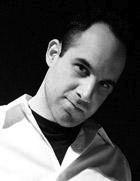 Our art director Robyn Gorgos and gaffer Phillip Smith built the interior of a motel room from scratch. Check out our production stills - linked near the top of the page and near the bottom of the page - to see the motel room for yourself. Incredible, simply incredible.
Our art director Robyn Gorgos and gaffer Phillip Smith built the interior of a motel room from scratch. Check out our production stills - linked near the top of the page and near the bottom of the page - to see the motel room for yourself. Incredible, simply incredible.
Producer Katy and production manager John also contributed to the construction effort. It goes without saying that in independent cinema, virtually everyone who has a stake in a movie takes on extra jobs above and beyond their credited position. Director Jason and yours truly (composer Ryan) drove around the seediest parts of the San Gabriel Valley to furnish the seedy motel room set with equally seedy set dressings.
The budget of the movie - while it ultimately was just right to make the movie possible - didn't allow for truck rental to haul the furniture for the motel, and we couldn't come up with anyone within a 50 mile radius to loan us such a vehicle. So we had to transport a scuzzy bed comforter, a lampstand drawer, a couple of lamps, and a headboard (and probably more stuff) in Jason's four-door sedan, all at once. The intuition strengthened while playing Tetris was definitely helpful for this occasion.
But when the headboard didn't fit quite right for the trunk, that's when Jason became a lumberjack (of sorts):
We'd like to give Salvation Army guy some thanks for his assistance, i.e., the rusty saw (which was better than nothing).



Check out our Élan Vital Production Stills!
Friday, August 31, 2007
Jason J. Loya: Writer / Director / Lumberjack
Posted by
Ryan DeRamos
at
8:09 PM
0
comments
![]()
![]()
Labels: jason loya, lumberjack, motel room, phillip smith, production, robyn gorgos, set building, set dressing
Wednesday, August 29, 2007
A Quick One

Check out the two waveform blocks just below the character Steve (played magnanimously by Mike Onofri). The one to the left is SoundSoaped, while the one on the right is simply a normalized version of the raw sound footage. Visually, the waveform on the left looks good - the two bits of foreground sound are prominent and the dead spaces are, if you'll pardon the pun, flatlined. The one on the right looks like it contains a lot of background noise.
But you'll actually have to hear the modified section to make sure it sounds right for the film. If not, here's a possible hint for the next step: EQ.
Posted by
Ryan DeRamos
at
12:42 AM
1 comments
![]()
![]()
Labels: dialogue editing, postproduction sound, sound design
Monday, August 27, 2007
Dialogue Editing
Today's magic words are elbow grease.
As you can see, I've ironically unmade what the editor has made, so I can isolate the audio from various takes to use BIAS Soundsoap Pro for noise reduction, as well as to apply varying degrees of panning and volume for the individual characters in the movie.
I'm pretty sure there are some easier ways to go about the digital video editing bay/digital audio workstation (DAW) divide, such as:
1. Presumably - but don't quote me on this - using Apple Final Cut Pro for video and Apple Logic Pro for audio.
2. Avid Media Composer for video and Digidesign Pro Tools for audio - Digidesign being a subsidiary of Avid.
3. Adobe Premiere for video and Adobe Audition for audio.
I might just be blowing smoke, but chances are if you're using the same company's products for postproduction, your workflow process will be simpler and more efficient.
We are doing no such thing for Elan Vital. Jason's cutting picture with Final Cut, and I'm cutting and adding sound with Pro Tools. But again, think elbow grease.
And you can tell from the screenshot, I'm running Pro Tools M-Powered 7.3.1 on an otherwise outdated system running Windows XP. Again, elbow grease. Well, okay - elbow grease - as well as decent computer brain power (RAM and processor), and a decent USB/Firewire/PCI Card audio interface, namely something cool made by M-Audio or Digidesign. But the rest is all will and determination.
So I've chopped the entire dialogue track into manageable pieces to SoundSoap and pan and change levels. It's also a good idea to fill in the gaps caused by the jigsaw puzzle that I've created with some relatively clean-sounding room tone, that is, room tone that'll match the SoundSoaped files. That probably means somewhat SoundSoaping the room tone too.
When that's all done - and we're not even close to tell you the truth - we'll finally know which parts of dialogue can be saved, and which parts we'll need to get in ADR. Yes, ADR...automated dialogue replacement or additional dialogue recording...same thing. I can tell you right off the bat, distorted audio - where the boom was too close to a louder-than-usual actor - will have to be replaced. Unfortunately, we have a handful of spots where that was the case...the boom and actor(s), wrong place, wrong time. ADR, which we'll save for another exciting blog entry, here we come!
(Of course, the proper way around the distortion problem is to record the audio separate from video - not on the same DV tape - with a production sound mixer always on guard and in perfect synchronization with the boom operator. And speaking of sync, you'd also need an extra machine to burn timecode on both the audio recorder and the video/film recorder. We had no such luxury for Elan Vital. And if you are reading this blog for information to help your project, chances are that you won't have a large enough budget either. Again, elbow grease.)
The big lesson I'm trying to stress here is if you aren't granted the luxury of expensive equipment, in grand quantities thereof, or the luxury of extra crew positions, also in grand quantities thereof, you'll need to put in (1) some harder-than-hard, hard work and (2) some creativity that goes beyond the creativity of the creative process. Just remember the old adage: Necessity is the mother of invention. Also remember the Mothers of Invention's album Freak Out!, which is what not to do when faced against seemingly insurmountable odds.
Anyhow, this is BIAS SoundSoap Pro:
But if you want something simpler and less expensive for noise reduction, I suggest BIAS SoundSoap 2:
SoundSoap Pro is only a plug-in, and a pricey one at that, so you'll need a host program, like Pro Tools or another DAW that accepts RTAS or VST plugins. SoundSoap 2, on the other hand, is both a plug-in and a stand-alone program. For best results with SoundSoap 2, you'll have to find a happy medium between noisy and that flanged, audio in the bathroom sound if you go overboard.
And here are the pairs that might help with workflow issues:
Final Cut Pro and Logic Pro. Actually Final Cut Studio contains Final Cut Pro and Soundtrack, which might be a sufficient audio program, depending on your needs:
In lieu of Media Composer, here are Avid Liquid and Pro Tools M:
If you want something more robust from Avid, here are Xpress Pro and Pro Tools HD, you big spender:
Premiere Pro and Audition:
Until next time...elbow grease.
Posted by
Ryan DeRamos
at
5:04 AM
1 comments
![]()
![]()
Labels: dialogue editing, postproduction, postproduction sound, rough cut, sound
Monday, August 20, 2007
Sound Effects
There's only so much I can do with sound-wise with the rough cut of Elan Vital. Do I begin dialogue editing? Do I layer in the sound design? Do I continue the music work that I've begun in preproduction?
The answer should be yes to all three. However, since I'm my own personal sound triumvirate (or audio trinity, if you like) - and if you, the reader, find yourself in the same predicament - it would be best to do the entire process, as well as you can, one step at a time.
Anyway, the director (Jason) and I agreed that compiling sounds for the effects track would benefit the postproduction process most at the rough cut stage. And so here I am working on the effects track (which deceptively will contain a plethora of tracks).
For a movie like Elan Vital, sound effects will take the following forms:
1. Foley work. I'm essentially going to be the unquiet mime of the movie. It's going to equally be the obvious sounds (the bartender cleaning glasses, footsteps, etc.) and the subtle (clothing that rubs together while the bartender cleans glasses, for instance).
I only have the ability to use two microphones simultaneously, but that still gives us some good opportunities. Two microphones can either create true stereo on the spot (the difference between panning a mono track in a digital audio workstation [DAW] versus having the sound actually travel in stereo), or variety of mic placement (one mic close to the sound and one far away to incorporate the sound of the room). Alternatively, one mic can be placed close to the main sound (a towel cleaning a glass, for instance) and another can be placed on the secondary sound (clothes rubbing due to bodily movement), and the appropriate proportion of the two can be mixed within the DAW.
Of course, I'm not recording at the most ideal of Foley stages, and it is a hot summer during the daytime. Needless to say, most of the microphone recording currently takes place during cooler, vampiric hours. If it didn't occur to you already, innovation is a definite requirement in the creation of independent cinema.
2. Heavily-processed effects library samples. Of course, this will be a last resort for the un-Foley-able sounds. If and when I have to incorporate previously made sounds, as a rule of thumb, the sounds will never be left as-is. You need to tweak them with whatever DAW you're using. In my case, I'm thankfully using Pro Tools. If all goes well, it'll be like photoshopping for the ears (since Pro Tools does share a similar infamy as Photoshop).
3. Harmonic (and dissonant) ambience (or ambiance, as both spellings seem to be correct). Generally it's not the most ideal situation when the sound designer is also the music composer, for obvious reasons. However, one advantage to have the two-in-one is that the music and the the music-like effects will seemlessly come together without much argument. (That is, if said sound designer/musician doesn't suffer from a mental disorder.) Anyway, I'm creating some of the ambience using both organic and virtual instruments (just like the soundtrack).
As far as virtual instruments go, there are several free VSTi plugins on the web, which will require a lot of work searching and researching. If you're using Pro Tools, you'll need a VST to RTAS wrapper to use those plugins. FXpansion is the only company that I know of that creates such a product. There are also several commercial VST and RTAS plugins (and other types), but they can be extremely expensive and cost prohibitive, especially when you are your own film investor. Digidesign (the company behind Pro Tools) offers a free RTAS instrument plugin called Xpand!, which I'm excited to use for Elan Vital. Not only does Xpand! have simulated traditional instruments (which sound really great, I might add), there's a library of ethereal-ness that may work for this movie.
Here's the VST-RTAS wrapper I'm talking about:
And here are several levels of Pro Tools you can choose from (depending on your budget):
Also be aware that you'll need a qualified M-Audio interface to run Pro Tools M-Powered. Pro Tools LE comes with the Mbox and Digi interfaces, and if you're going to use Pro Tools HD, I salute you.
Posted by
Ryan DeRamos
at
2:51 AM
0
comments
![]()
![]()
Labels: postproduction, postproduction sound, rough cut, sound, sound design, sound effects
Thursday, August 9, 2007
Some New Pics
We've released some new stills from the production - straight from the Canon XL2. They lose some quality in the conversion and upload but for stills, they look great. Click here to see them in the "More Elan Vital Stills" album: http://picasaweb.google.com/mutinyuniverse. Otherwise, editing is going well. All looks great. It is a slow process but it's better that way. I did not set out to efficiently make a product. When the film lives up to the one in my head, it will be complete. Jason
Posted by
Jason J. Loya
at
3:15 PM
0
comments
![]()
![]()
Labels: canon, editing, elan vital, jason loya, photo album, photos, pictures, process, production, stills, xl2



Check out our Élan Vital Production Stills!





